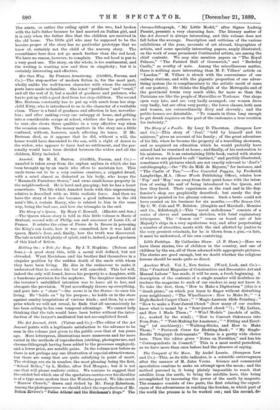The Art Journal, 1889. (Virtue and Co.)—The editor of the
Art Journal points with a legitimate satisfaction to the advance to be seen in the volume just given to the public over that of ten years ago. More letterpress, illustrations more numerous and far more varied in the methods of reproduction (etching, photogravure, and chromo-lithograph having been added to the processes employed), and a lower price, are notable gains. In the volume now before us there is not perhaps any one illustration of especial attractiveness, but there are many that are quite satisfying in point of merit. The etchings are six in number, the most pleasing being the first, "School Belles," by L. Muller, after Ned Morgan ; but it is not one that will please realistic critics. We venture to suggest that the cricket-bat which one of the spectators carries over his shoulder is of a type more modern than the Waterloo period. We like much "Harrow Church," drawn and etched by Mr. Percy Robertson. Among the photogravures we should select the reproduction of Mr. Briton Riviere's "Pallas AthenO and the Herdsman's Dogs." The chromo-lithograph, "My Little Model," after Signor Ludwig Pa.ssini, presents a very charming face. The literary matter of the Art Journal is always interesting, and this volume does not fall below the average. Description and criticism of the various exhibitions of the year, accounts of art abroad, biographies of artists, and some specially interesting papers, amply illustrated, on the work of some prominent Continental artists, are among the chief contents. We may also mention papers on "The Royal Palaces," "The Painted Hall of Greenwich," and "Berkeley Castle," as worthy of note. Among the miscellaneous matter, there is nothing more interesting than M. P. Villars' article on "London." M. Villars is struck with the convenience of our railway stations, and with the gigantic proportion of our adver- tising system (he is complimentary to the artistic merit of some of our posters). He thinks the English of the Metropolis and of the provincial towns very much alike, far more so than the Parisians are like the people of Marseilles or Toulouse. Our shops open very late, and are very badly arranged; our women dress very badly, but are often very pretty; the lower classes, both men and women, are extraordinarily dirty and slovenly; and the public-houses are detebtable. "To remain in them long enough to get drunk requires on the part of the customers a true vocation for inebriety."










































 Previous page
Previous page